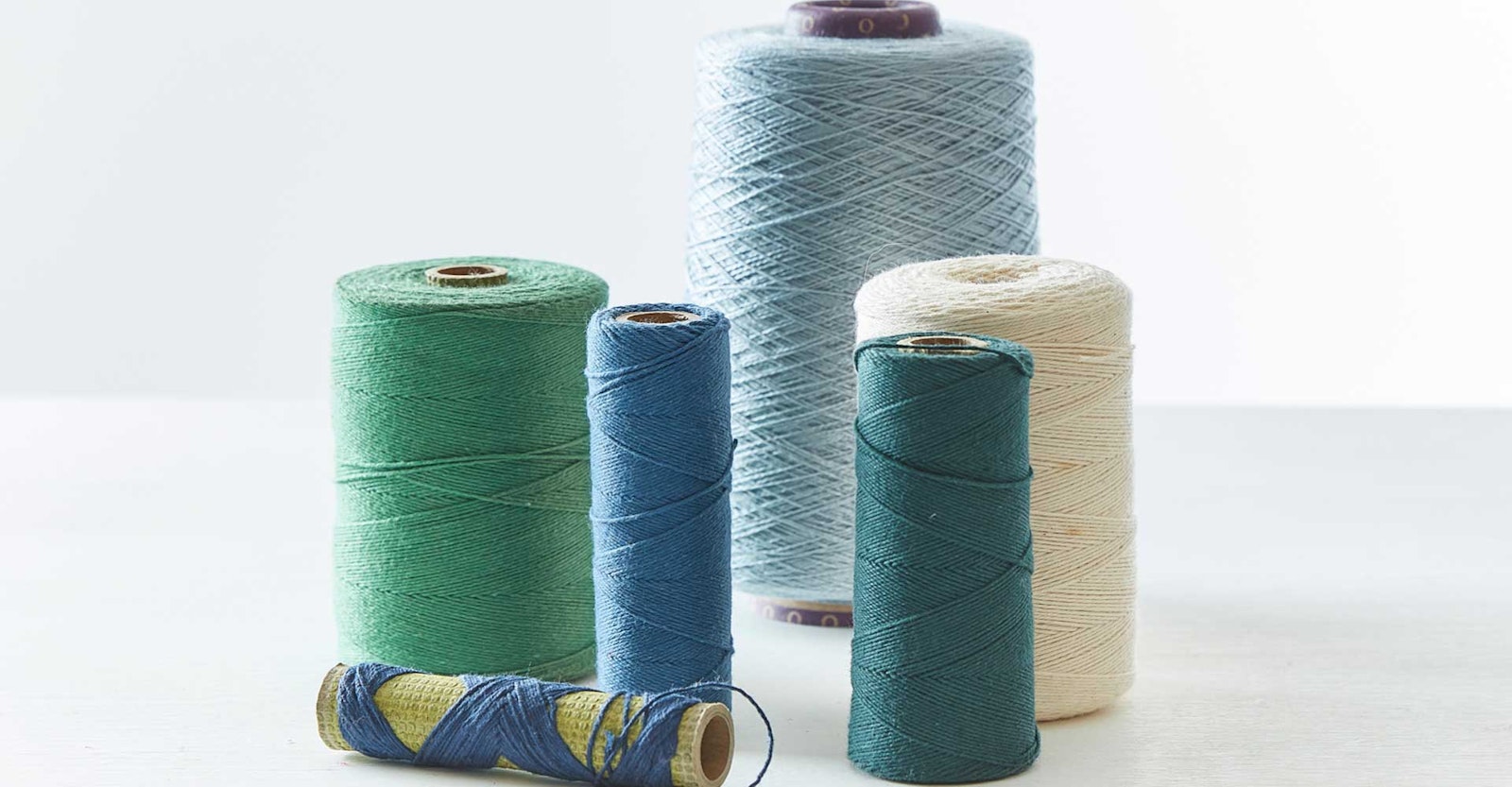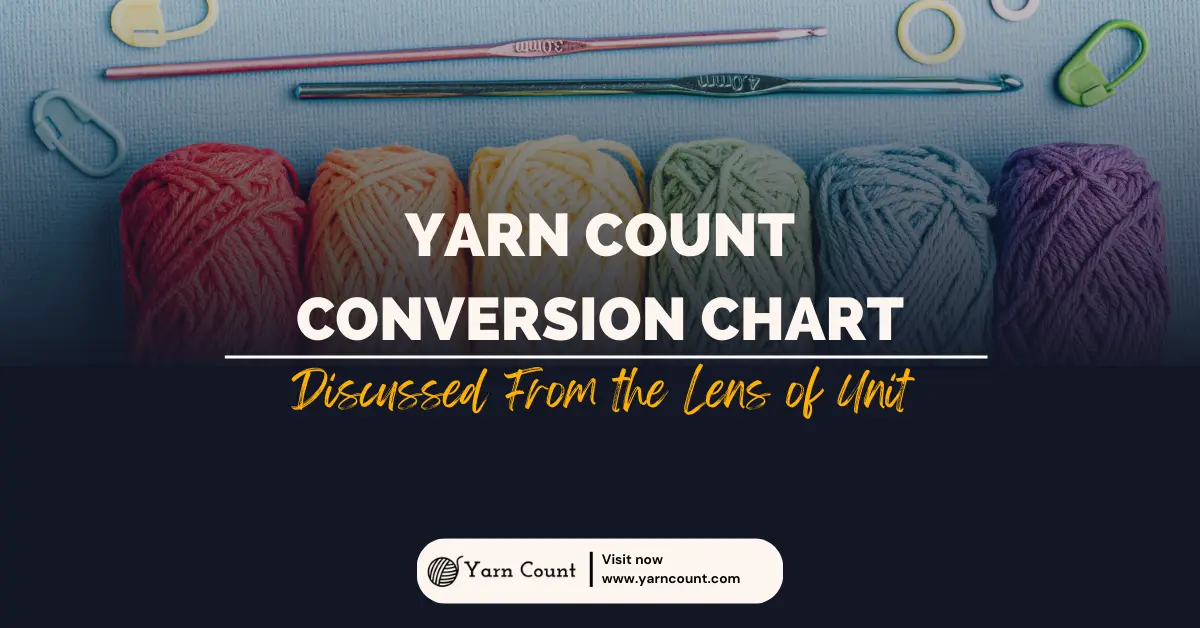The yarn count conversion formula is a simple calculation used to convert the count of yarn from one system to another. It helps in determining the thickness and weight of the yarn.
Yarn count is an important parameter in the textile industry as it impacts the quality and appearance of the fabric. By using the formula, manufacturers can ensure consistency in their production process and meet the desired specifications for different applications.
Understanding the yarn count conversion formula is essential for textile professionals to effectively communicate and work with different count systems used globally. We will discuss the yarn count conversion formula and how it can be applied in practice.
Table of Contents

Credit: handwovenmagazine.com
Understanding Yarn Count And Its Importance
In the world of textiles, yarn count holds significant importance as it directly influences the quality and characteristics of fabric. By understanding yarn count, manufacturers and industries can ensure accurate thread measurement, resulting in superior products and satisfied customers. This article will delve into the concept of yarn count, its role in determining fabric quality, and the importance of precise thread measurement in various textile industries. Let’s explore these aspects in detail.
What Is Yarn Count And Why Is It Important?
Yarn count refers to the measurement of the fineness or thickness of a yarn. It indicates the quantity of yarn material per unit length, such as length or weight. Understanding yarn count is crucial for textile manufacturers as it directly affects the fabric’s appearance, strength, and performance. By determining the yarn count, manufacturers can select the suitable yarn for their specific fabric requirements.
The Role Of Yarn Count In Determining The Quality And Characteristics Of Fabric
The yarn count plays a pivotal role in defining the quality and characteristics of fabric. A higher yarn count generally indicates a finer and smoother yarn, resulting in a more luxurious and soft fabric. On the other hand, a lower yarn count suggests a coarser and thicker yarn, resulting in a fabric with a heavier and stiffer feel.
Moreover, yarn count also affects the fabric’s strength and durability. Fabrics with a higher yarn count tend to be stronger and more resistant to wear and tear. This makes them ideal for applications requiring robust and long-lasting textiles, like upholstery and heavy-duty garments.
Additionally, the yarn count is closely related to the fabric’s density and appearance. A higher yarn count often leads to a denser fabric with a smoother surface, creating a crisp and refined look. Conversely, a lower yarn count produces a looser and more open weave, resulting in a fabric with more breathability and texture.
Importance Of Accurate Thread Measurement In Different Textile Industries
Accurate thread measurement is crucial in various textile industries to ensure consistent quality and meet customer expectations. Whether it’s the fashion industry creating exquisite garments, the home textile sector producing comfortable bedding, or the automotive industry developing durable upholstery, precise thread measurement is a non-negotiable aspect.
By adhering to accurate yarn count measurements, textile manufacturers can achieve uniformity in their products, ensuring consistency across batches. This not only enhances customer satisfaction but also streamlines production processes, reducing wastage and optimizing resource allocation.
Furthermore, precise thread measurement enables manufacturers to calculate the required amount of yarn accurately, eliminating excessive material usage and minimizing costs. It also ensures the fabric’s desired characteristics are achieved, such as the desired level of softness, durability, and breathability, among others.
In conclusion, understanding yarn count and its importance is essential for fabric manufacturers and various textile industries. By comprehending the role of yarn count in determining fabric quality and characteristics, as well as emphasizing accurate thread measurement, industries can deliver superior products, meet customer expectations, and enhance their overall competitiveness.
Different Methods Of Measuring Yarn Count
Yarn count can be measured using different methods, and one popular way is through the yarn count conversion formula. This formula allows for accurate and efficient conversion of yarn count measurements.
Direct Yarn Count Method And Its Calculation Formula
The direct yarn count method is one of the two primary methods used to measure yarn count. It involves directly measuring the length and weight of a specific amount of yarn. This method is widely used in the textile industry and is known for its accuracy and simplicity.
To calculate the yarn count using the direct method, you can use the following formula:
Yarn Count = Length (in meters) / Weight (in grams)This formula allows you to determine the yarn count by dividing the length of a yarn sample in meters by its weight in grams. By obtaining these two measurements, you can easily calculate the yarn count using this simple formula.
Indirect Yarn Count Method And Its Calculation Formula
The indirect yarn count method is an alternative way of measuring the yarn count. It involves calculating the yarn count based on other yarn parameters such as the number of twists per unit length or the number of yarn fibers per unit area.
To calculate the yarn count using the indirect method, you can use the following formula:
Yarn Count = [(Length × Specific Gravity) / (Weight × Twist Factor)]This formula incorporates additional variables such as specific gravity and twist factor to calculate the yarn count indirectly. Specific gravity refers to the ratio of the density of the yarn material to the density of water, while the twist factor represents the number of twists per unit length of the yarn.
Comparison Of Direct And Indirect Methods
When comparing the direct and indirect methods of measuring yarn count, it’s essential to consider their respective advantages and disadvantages.
| Direct Method | Indirect Method |
|---|---|
| Simple and accurate measurement | Allows for calculation based on other yarn parameters |
| Requires direct measurement of length and weight | Depends on additional variables such as specific gravity and twist factor |
| Commonly used in the textile industry | Offers versatility in calculating yarn count |
Pros And Cons Of Each Method
When it comes to the direct method, its simplicity and accuracy make it a popular choice among textile manufacturers. However, it does require the direct measurement of length and weight, which can be time-consuming.
On the other hand, the indirect method allows for calculation based on various yarn parameters, providing versatility in determining the yarn count. However, it relies on additional variables such as specific gravity and twist factor, which may introduce more complexity to the measurement process.
Overall, both methods have their pros and cons, and the choice between them depends on specific requirements, accuracy needs, and the available resources. Understanding these different methods of measuring yarn count is crucial for ensuring the quality and consistency of yarn production in the textile industry.
Yarn Count Conversion: Converting Between Different Measurement Systems
Yarn count is an essential factor in the textile industry, determining the thickness and quality of yarn. However, the international textile market often uses different measurement systems, causing confusion when it comes to comparing yarn counts between different regions. Understanding how to convert between the metric count and the English count system is crucial for accurate communication and trade. In this section, we will explore the formulas and common conversions required to convert yarn counts seamlessly.
Converting From The Metric Count To The English Count System
When converting yarn count from the metric to the English system, it’s vital to use the correct formula to ensure accurate results. The formula for converting the metric count (Nm) to the English count (Ne) is as follows:
This formula allows for a quick and precise conversion, enabling you to determine the English count by dividing the constant value of 590.5 by the given metric count.
Converting From The English Count To The Metric Count System
Conversely, when you need to convert yarn count from the English system to the metric system, a different formula comes into play. The calculation formula for converting the English count (Ne) to the metric count (Nm) is as follows:
By dividing the constant value of 590.5 by the English count, you can easily obtain the equivalent metric count.
Common Conversions Used In The Textile Industry
In the textile industry, several common yarn count conversions are frequently used, allowing for smooth trade and production processes. Some of these conversions include:
| English Count (Ne) | Metric Count (Nm) |
|---|---|
| 2/0 | 6.7 |
| 3/0 | 5.6 |
| 4/0 | 4.7 |
| 5/0 | 3.8 |
Knowing these common conversions is essential for effective communication and understanding across the textile industry.
Practical Applications Of Yarn Count Conversion
Yarn count conversion is a fundamental concept in the textile industry that is utilized in various processes to ensure the production of high-quality fabrics and garments. Understanding how to convert yarn counts is essential for textile manufacturers, weavers, knitters, and other industry professionals. In this blog post, we will explore the practical applications of yarn count conversion and its importance in maintaining product consistency. Let’s dive in!
How Yarn Count Conversion Is Used In Different Textile Processes
The conversion of yarn counts plays a crucial role in several textile processes, enabling efficient production and consistent results. Here are a few examples:
- Fabric Manufacturing: Fabric manufacturers often work with yarns of different counts to create diverse types of fabrics. Yarn count conversion formulas allow them to seamlessly transition between different count systems, ensuring consistent fabric quality.
- Knitting: Knitters rely on accurate yarn count conversion to determine the appropriate yarns for knitting projects. By converting yarn counts, knitters can choose the right yarn thickness, maintaining control over stitch gauge, drape, and overall fabric appearance.
- Weaving: Weavers use yarn count conversion to select the appropriate yarns for their weaving patterns. Accurate yarn count conversion allows weavers to achieve the desired fabric density, texture, and strength, resulting in high-quality woven fabrics.
Examples Of Yarn Count Conversion In Fabric Manufacturing
In fabric manufacturing, yarn count conversion plays a crucial role in ensuring consistent fabric quality. Let’s consider a practical example:
Suppose a fabric manufacturer received a customer order specifying a certain fabric count in Metric Count (Ne) system, while their production machines are calibrated in the English Count (Ne) system. The manufacturer must convert the yarn count from one system to the other to select the appropriate yarns and achieve the desired fabric quality.
By utilizing the yarn count conversion formula, the manufacturer can easily convert the count and determine the ideal yarns that meet the customer’s requirements. This enables a smooth production process, maintaining consistency in fabric construction and characteristics.
Yarn Count Conversion In Knitting And Weaving Processes
Yarn count conversion is equally crucial in both knitting and weaving processes, albeit with slightly different considerations:
- Knitting: Knitters convert yarn counts to choose the desired yarn thickness, determining the number of stitches per inch or centimeter. This conversion helps them achieve the desired fabric drape, elasticity, and stitch pattern.
- Weaving: Weavers convert yarn counts to select the appropriate yarns, ensuring the desired fabric density and appearance. The conversion enables weavers to maintain a consistent warp and weft balance, resulting in a uniform and aesthetically pleasing woven fabric.
Importance Of Accurate Yarn Count Conversion For Product Consistency
The accuracy of yarn count conversion is pivotal for ensuring product consistency throughout the textile production process. By adhering to precise yarn count conversion calculations, manufacturers can:
- Maintain consistent fabric quality across different production batches.
- Ensure the desired fabric characteristics, such as thickness, texture, and strength, are consistently achieved.
- Produce garments or textiles with uniform stitch patterns, drape, and appearance.
- Minimize variations in fabric construction, reducing the risk of defects and customer dissatisfaction.
Accurate yarn count conversion allows textile industry professionals to make informed decisions about yarn selection, ensuring the production of high-quality fabrics and garments that meet customer expectations consistently.
Tips And Best Practices For Successful Yarn Count Conversion
Converting yarn count is an essential process for any textile manufacturer or fabric supplier. Whether you are working with cotton, wool, or synthetic fibers, accurate yarn count conversion is crucial to ensure uniformity and consistency in your final product. In this section, we will discuss some tips and best practices to help you successfully convert yarn count, avoiding common mistakes and ensuring accuracy. By following these guidelines, you can streamline your production process and deliver high-quality textiles.
Precautions To Take During The Conversion Process
During the yarn count conversion process, it is important to take certain precautions to ensure the accuracy of your calculations. Here are some precautions you should consider:
- Double-check the conversion formula: Before proceeding with any conversion, it is vital to verify the conversion formula you are using. Different countries or regions may use slightly different formulas, so make sure to use the appropriate one for accurate results.
- Use high-precision measuring equipment: To obtain precise measurements, it is essential to use calibrated measuring equipment. Invest in quality tools such as a digital micrometer or an electronic balance to minimize potential measurement errors.
- Work with standardized units: Standardize all your measurements to a consistent unit system, such as the metric system. This will ensure consistency and compatibility throughout the conversion process.
Common Mistakes To Avoid When Converting Yarn Count
Converting yarn count can be a complex process, and it’s easy to make mistakes. To save time and prevent errors, avoid these commonly made mistakes:
- Incorrect formula usage: Using the wrong conversion formula can lead to inaccurate results. Make sure you are employing the appropriate formula based on the yarn count system you are converting from and to.
- Insufficient sample size: When converting yarn count, it’s crucial to use an adequate sample size to obtain a representative measurement. Using a small sample size can result in skewed data and unreliable conversions.
- Ignoring yarn characteristics: Yarn count doesn’t exist in isolation; it is influenced by various factors such as yarn twist, fiber density, and moisture content. Failing to consider these characteristics can lead to inaccurate conversions.
Techniques To Ensure Accurate And Reliable Yarn Count Conversion
To ensure accuracy and reliability in your yarn count conversions, consider implementing these techniques:
- Calibrate your equipment regularly: Regular calibration of measuring equipment such as counters and balances is essential to maintain accuracy. Incorporate a calibration schedule to ensure reliable measurements.
- Take multiple measurements: To minimize errors, take multiple measurements of the same yarn sample and calculate the average. This helps to compensate for any inconsistencies or outliers in your readings.
- Consult with experts: If you are unsure about any aspect of the yarn count conversion process, seek guidance from experienced textile professionals or experts. Their knowledge and expertise can provide valuable insights and help you avoid potential pitfalls.
Resources And Tools Available For Yarn Count Conversion
Fortunately, there are various resources and tools available to assist you in yarn count conversion. Here are some reliable options:
| Resource/Tool | Description |
|---|---|
| Yarn Count Conversion Charts | These charts provide pre-calculated conversion values and formulas for easy reference. |
| Online Yarn Count Conversion Calculators | Web-based calculators that allow you to input your yarn count values and automatically calculate the converted value. |
| Textile Industry Associations | The textile industry associations often provide resources, guidelines, and expert advice on yarn count conversion. |
By utilizing these resources and tools, you can save time and effort while ensuring the accuracy of your yarn count conversions.
Frequently Asked Questions Of Yarn Count Conversion Formula
How Do You Convert Tex To Denier In Yarn Count?
To convert tex to denier in yarn count, divide the tex value by 9. Since 1 tex is equal to 9 denier, this conversion formula helps in determining the denier value of the yarn accurately.
What Is The Formula To Convert Denier To Tex In Yarn Count?
To convert denier to tex in yarn count, multiply the denier value by 0. 111. This formula is used to accurately determine the tex value of the yarn based on the given denier measurement.
How Does The Nm Count Relate To Yarn Count Conversion?
The Nm count is a measure of yarn weight in metric units. It represents the number of kilometers of yarn that weigh one kilogram. To convert Nm count to tex or denier, the yarn weight is divided by the Nm count.
What Are The Common Units Used In Yarn Count Conversion?
The common units used in yarn count conversion are tex and denier. Tex represents the weight in grams of 1,000 meters of yarn, while denier measures the weight in grams of 9,000 meters of yarn.
Conclusion
Understanding the yarn count conversion formula is essential for anyone working with different types of yarn. By knowing how to convert yarn counts, you can easily switch between yarns of different thicknesses and ensure your projects turn out as desired.
Whether you’re a knitter, crocheter, or textile professional, mastering this conversion formula will enhance your skills and allow you to explore a wider range of projects. So, go ahead and dive into the fascinating world of yarn count conversions and elevate your yarn crafting journey.

